
The Ajanta Caves are approximately 30 rock-cut Buddhist cave monuments dating from the 2nd century BCE to about 480 CE in the Aurangabad district of Maharashtra state in India. The caves include paintings and rock-cut sculptures described as among the finest surviving examples of ancient Indian art, particularly expressive paintings that present emotions through gesture, pose and form.

In Buddhism, a bodhisattva or bodhisatva is a person who is on the path towards bodhi ('awakening') or Buddhahood.
The Jātakas are a voluminous body of literature native to India which mainly concern the previous births of Gautama Buddha in both human and animal form. According to Peter Skilling, this genre is "one of the oldest classes of Buddhist literature." Some of these works are also considered great works of literature in their own right.
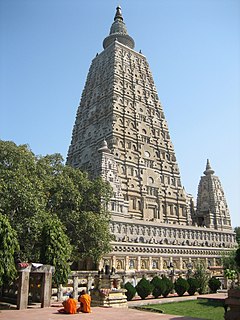
The Mahabodhi Temple or the Mahābodhi Mahāvihāra, a UNESCO World Heritage Site, is an ancient, but rebuilt and restored Buddhist temple in Bodh Gaya, Bihar, India, marking the location where the Buddha is said to have attained enlightenment. Bodh Gaya is 15 km from Gaya and is about 96 km (60 mi) from Patna.

Sanchi is a Buddhist complex, famous for its Great Stupa, on a hilltop at Sanchi Town in Raisen District of the State of Madhya Pradesh, India. It is located, about 23 kilometres from Raisen town, district headquarter and 46 kilometres (29 mi) north-east of Bhopal, capital of Madhya Pradesh.
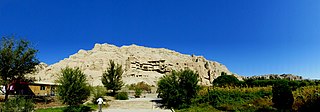
The Kizil Caves are a set of Buddhist rock-cut caves located near Kizil Township in Baicheng County, Aksu Prefecture, Xinjiang, China. The site is located on the northern bank of the Muzat River 65 kilometres west of Kucha. This area was a commercial hub of the Silk Road. The caves have an important role in Central Asian art and in the Silk Road transmission of Buddhism, and are said to be the earliest major Buddhist cave complex in China, with development occurring between the 3rd and 8th centuries CE. The caves of Kizil are the earlier of their type in China, and their model was later adopted in the construction of Buddhist caves further east. Another name for the site has been Ming-oi, although this term is now mainly used for the site of Shorchuk to the east.

Dipankara or Dipankara Buddha is one of the Buddhas of the past. He is said to have lived on Earth four asankheyyas and one hundred thousand kappas ago. According to some Buddhist or folk traditions, Dipankara was a previous Buddha who attained Enlightenment eons prior to Gautama Buddha, the historical Buddha.

Bharhut is a village located in the Satna district of Madhya Pradesh, central India. It is known for its famous relics from a Buddhist stupa. What makes Bharhut panels unique is that each panel is explicitly labelled in Brahmi characters mentioning what the panel depicts. The major donor for the Bharhut stupa was King Dhanabhuti.
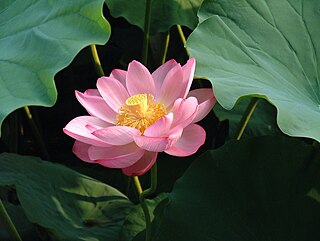
The lotus, Nelumbo nucifera, is an aquatic plant that plays a central role in the art of Indian religions such as Hinduism, Buddhism, Jainism and Sikhism.
{{Infobox royalty | name = Yaśodharā | image = Yasodhara.jpg | alt = | caption = Yasodhara, Wat Pho, Bangkok, Thailand | spouse = Siddhartha</ref> | father = Suppabuddha | mother = Amita | birth_name = | birth_date = c. 563 BCE}

The miracles of Gautama Buddha refers to supernatural feats and abilities attributed to Gautama Buddha by the Buddhist scriptures. The feats are mostly attributed to supranormal powers gained through meditation, rather than divine miracles. Supranormal powers the historic Buddha was said to have possessed and exercised include the six higher knowledges (abhiññā): psychic abilities (iddhi-vidhā), clairaudience (dibba-sota), telepathy (ceto-pariya), recollection of one's own past lives (pubbe-nivāsanussati), seeing the past lives and rebirths of others (dibba-cakkhu), and the extinction of mental intoxicants (āsavakkhaya). Miracles found in Mahayana sutras generally play a more direct role in illustrating certain doctrines than miracles found in non-Mahayana Buddhist texts. Apart from texts, several of the miracles are often shown in scenes of the life of Buddha in art.

The UNESCO World Heritage Site Buddhist Monuments in the Hōryū-ji Area includes a variety of buildings found in Hōryū-ji and Hokki-ji in Ikaruga, Nara Prefecture, Japan. These buildings were designated in 1993 along with the surrounding landscape, under several criteria. The structures inscribed are some of the oldest extant wooden buildings in the world, dating from the 7th to 8th centuries. Many of the monuments are also National Treasures of Japan, and reflect an important age of Buddhist influence in Japan. The structures include 21 buildings in the Hōryū-ji East Temple, 9 in the West Temple, 17 monasteries and other buildings, and the pagoda in Hokki-ji.

The Tamamushi Shrine is a miniature shrine owned by the Hōryū-ji temple complex of Nara, Japan. Its date of construction is unknown, but estimated to be around the middle of the seventh century. Decorated with rare examples of Asuka-period paintings, it provides important clues to the architecture of the time and has been designated a National Treasure.

In Buddhist texts, Sumedha is a previous life of Gotama Buddha in which he declares his intention to become a Buddha. Buddhist texts describe that this takes place when Gotama Buddha is still a Buddha-to-be. Traditions regard Sumedha's life as the beginning of the spiritual journey leading up to the attainment of Buddhahood by Gotama in his last life, a journey which takes place through many lifetimes. Born in a brahmin family, Sumedha begins to live as an ascetic in the mountains. One day he meets Dīpankara Buddha and offers his own body for him to walk over. During this sacrifice, he makes a vow that he also will be a Buddha in a future lifetime, which is confirmed by Dīpankara through a prophecy.
Buddhavanam is a tourism project in Nagarjuna Sagar, Telangana created by the Telangana State Tourism Development Corporation. The project was sanctioned by the Government of India viz., Integrated Development of Nagarjunasagar as part of Lower Krishna valley Buddhist circuit with a view to attract large number of domestic and foreign tourists particularly from the South-East Asian countries.
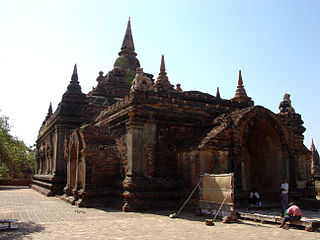
Abeyadana temple is a 12th century Buddhist temple in Bagan, Myanmar. The temple complex has a large central temple, which has a rectangular plan.
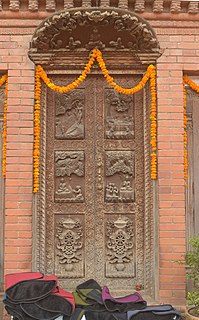
The Buddhist traditions have created and maintained a vast body of mythological literature. The central myth of Buddhism is the life of the Buddha. This is told in relatively realistic terms in the earliest texts, and was soon elaborated into a complex literary mythology. The chief motif of this story, and the most distinctive feature of Buddhist myth, is the Buddha's renunciation: leaving his home and family for a spiritual quest. Alongside this central myth, the traditions contain large numbers of smaller stories, which are usually supposed to convey an ethical or Buddhist teaching. These include the popular Jātakas, folk tales or legends believed to be past lives of Gautama Buddha. Since these are regarded as episodes in the life of the Buddha, they are treated here as “myth”, rather than distinguishing between myth, legend, and folk-tale.

The Stupa No. 2 at Sanchi, also called Sanchi II, is one of the oldest existing Buddhist stupas in India, and part of the Buddhist complex of Sanchi in Madhya Pradesh. It is of particular interest since it has the earliest known important displays of decorative reliefs in India, probably anterior to the reliefs at the Mahabodhi Temple in Bodh Gaya, or the reliefs of Bharhut. It displays what has been called "the oldest extensive stupa decoration in existence". Stupa II at Sanchi is therefore considered as the birthplace of Jataka illustrations.

Narrative images of episodes from the life of Gautama Buddha in art have been intermittently an important part of Buddhist art, often grouped into cycles, sometimes rather large ones. However, at many times and places, images of the Buddha in art have been very largely single devotional images without narrative content from his life on Earth.

















